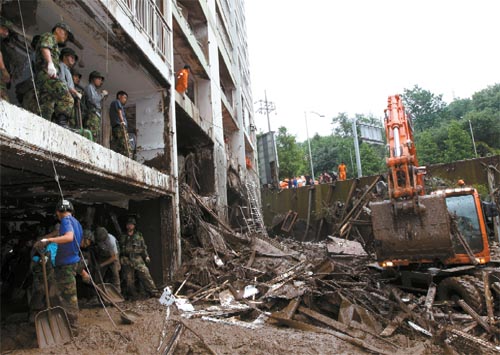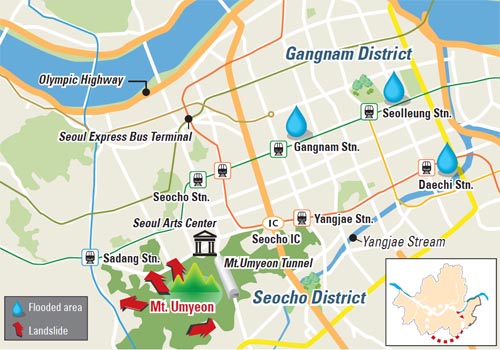A mountain becomes a monster

Soldiers and firefighters yesterday remove debris from an apartment complex that was hit by a landslide on Mount Umyeon in southern Seoul. [YONHAP]
A scenic mountain in the southern part of the capital that used to provide nearby residents with peace and tranquility turned into a monster Wednesday morning, taking the lives of at least 17 people in landslides.
And yesterday, criticism was being raised over stalled restoration work on Mount Umyeon - which had lost many trees in a typhoon last year - that might have contributed to the catastrophe.
The tragic landslides on Mount Umyeon Wednesday were triggered by the fiercest rain in nearly a century. Another round of heavy rain fell on the already-devastated neighborhood throughout yesterday as residents passed a sleepless night Wednesday, trembling with fear of further catastrophe.
On Wednesday afternoon, when a JoongAng Ilbo reporter visited the scene, many residents were seen staring blankly at their destroyed homes.
“I can’t believe it. It’s like hell,” said Jang Young-ja, 69, a resident of Jeonwon Village, where seven of the 17 were killed.
Another resident, Lee Choon-shim, 62, said: “Even though I want to do something about the damage, the water is out and the electricity is out and the mobile phone isn’t even working properly.
“A peaceful neighborhood that used to boast of its peacefulness fell into ruins in the blink of an eye.”

Apartments and houses struck by the landslides were destroyed or buried under a mass of mud, and a sea of muddy slush made the neighborhood look like a small island floating on water.
Scores of cars were tossed on top of each other and were tangled in uprooted trees. Several cars were even stuck in glass windows on the third floor of an apartment building. The first floors of buildings, apartments and homes were filled with stones and mud.
A total of eight landslides occurred on Mount Umyeon and devastated Hyeongchon, a village on the southeastern side of the mountain; Jeonwon, a village on the west side; and the Samsung Raemian apartment complex in Bangbae-dong.
“Because I live in an apartment just one behind [the damaged one], my home wasn’t directly harmed, but I couldn’t sleep last night because I was afraid there might be another landslide,” said a Samsung Raemian resident surnamed Kim, 28.
At the time of the landslides on Wednesday morning, rain was coming down at 70 millimeters (2.75 inches) per hour in Seocho District, southern Seoul.
Some believe the disaster could have been prevented.
Typhoon Kompasu swept through the Mount Umyeon area last September, taking down many trees in the process.
But government efforts to replace the trees had been slow, residents in the area said, leaving the mountain vulnerable to washouts and landslides. It was a disaster, some say, that was waiting to happen.
Residents criticized the Seocho District Office for not finishing the work being done in the area quickly enough before the rainy season arrived and said that “the dawdling construction work by the Seocho District Officeis responsible for [Wednesday’s] disaster.”
Jeong Kwon-young, 56, a resident of Bangbae-dong, said, “The residents here had filed several civil complaints [to the Seocho District Office], urging them to complete construction before the rainy season. We were all worried about the bare mountain with a lack of trees, and what we most feared has finally happened.”
A resident from Jeonwon surnamed Sim, 65, also said, “Many residents were concerned about trees that were bent or broken when Typhoon Kompasu hit the mountain. We requested the district office to remove those trees but we didn’t receive any response.”
The district office and Seoul city government expressed regret and said yesterday that the delay in restoration work was due to a delay in budget-securing procedures.
The district office and the city had planned the restoration work for many months, but the actual field work began in April.
“Preparing the budget to restore numerous mountains in Seoul that were affected by the typhoon last year took quite a while,” said Lee Choon-hee, chief of natural ecology for the city. “Mountains that needed urgent work were able to start but Mount Umyeon was so large in scale, the effort needed thoughtful steps.”
Work on Mount Umyeon began April 29, with an expected completion date of July 29, but heavy rain in June delayed the project, city officials said.
But experts pointed out that the city should have speeded up the work, considering that torrential downpours usually occur during the rainy season.
“When a person gets a scar, the skin around it becomes weak. Similarly, Mount Umyeon was weak after being swept by a typhoon last year,” said Seo Il-won, a professor of environment engineering at Seoul National University. “Because restoration work wasn’t done as quickly and the ground wasn’t as firm as it should have been, it triggered landslides.”
Seocho District Office said that it had temporarily suspended all construction work at Umyeon Ecological Park and is forbidding people from entering the mountain area. District officials as well as officials at the Korea Forest Research Institute and Sabang Association inspected the mountain yesterday and developed restoration measures.
Seoul Arts Center, which is located by the mountain, closed its gallery and postponed some of its performances Wednesday.
An official from the arts center said, “Closing the gallery due to rain damages has never occurred since its opening in 1988.”
A total of 1,200 fire authorities were dispatched to the damaged neighborhoods along with hundreds of police officers to control traffic and manage facilities.
Six thousand more soldiers were deployed to the area to engage in restoration work.
By Yim Seung-hye, Nam Hyeong-seok [sharon@joongang.co.kr]
한글 관련 기사 [CBS노컷]
8개월 전 경고된 `우면산 산사태`…정부 무대응이 禍(화) 불러
사면 관리 문제점 지적하고 대책 제시했는데도 수수방관
서울 서초구 우면산에서 발생한 산사태로 28일 현재 16명이 숨지고 1명이 실종됐다. 불과 몇 시간 만에 수백mm의 비가 쏟아진 기록적인 폭우 탓이라고만 하기에는 인명 피해가 너무 크고 처참하다.
"서울 서초구 방배동의 우면산 입구에는 뭉그러진 계곡에서 흘러내려 온 토사와 바위, 자갈, 나무 잔해들이 널브러져 있었다.
지난 추석 연휴 폭우로 산 정상 부근에서 산사태가 발생하면서 나무 3,000여 그루가 뽑혀 계곡을 따라 800m를 떠내려오면서 생긴 잔해들이다.
당시 토사물과 흙더미는 남부순환도로는 물론 방배2동 주택가까지 파고들어 이 일대를 아수라장으로 만들었다." (관련기사 : 2010년 12월 14일 노컷뉴스 보도 `비만 오면 무너지는 서울…추석 연휴에만 80곳 붕괴 첫 확인`)
지금으로부터 약 8개월 전인 지난해 12월 8일 취재진이 찾은 서울 우면산 모습이다.
CBS는 당시 `일상화된 기후변화, 대한민국이 위험하다`는 제목 아래 10회에 걸친 연속 기획보도를 통해 폭우와 폭설 등 일상화된 기후변화가 몰고 온 대형 재난에 대한 국내의 뒤쳐진 대응 실태를 고발하고, 선진국의 사례를 참고해 정책적 시사점을 제시했다.
◈ 우면산 일대는 인명피해 우려 큰 사면…10개월 만에 산사태 재발
이번에 산사태가 일어난 우면산 일대는 CBS가 지적한 서울 지역의 재해취약지구 가운데 대표적인 곳이었다.
인공적으로 만들어진 옹벽과 석축, 절개지 같은 사면(斜面)은 비가 많이 내릴 경우 붕괴 위험성이 크고, 사면이 무너지면 바로 인명피해로 이어지기 때문이다. 실제로 지난 10년 동안 급경사지 붕괴로 인한 사망자는 187명으로, 같은 기간 발생한 전체 인명피해 719명 가운데 26%를 차지한다.
서울시가 관리하고 있는 사면재해위험지구(산사태, 석축 붕괴 등이 가능한 지구)는 공식적으로 무려 301곳에 이르지만, 지난해 추석연휴 때 이 명단에 포함되지 않은 80곳이 붕괴됐다는 사실이 당시 CBS 취재결과 드러난 바 있다.
아까운 인명을 앗아간 우면산 역시 서울시가 놓친 곳 중의 하나였다.
당시 서울시립대 토목공학과 이수곤 교수는 "서울시가 관리하고 있는 300여곳이 아닌 감독하고 있지 않은 80곳이 붕괴된 건 우리나라가 산사태나 절개지 붕괴 등에 대비하는 게 거의 방임 수준이라는 걸 보여주는 대표적인 사례"라고 말했다.
◈ 사면 관리 전담부서 만들고 예방 대책 세웠어야
이에 CBS는 홍콩의 사면재해청 등을 참고해 별도의 관리기구를 신설하거나 일선 구청에 전담 부서를 만들 필요가 있다고 지적했다.
서울 지역 일선 구청만 봐도 임야의 사면과 절개지는 공원녹지과에서 담당하고 주택가 옹벽이나 석축은 건축과에서, 그리고 도로와 붙어 있는 사면은 도로과에서 각각 담당하고 있다.
행정 편의적으로 업무를 나눠 놓았을 뿐 전담 부서가 없고, 체계적인 관리를 하지 않으니 당연히 전문성이 떨어질 수밖에 없다.
더군다나 산 아래 버젓이 주택을 지을 때도 민간 업자에게 재해예방대책을 우선 마련하게 하는 식의 강제 규정도 없다.
우리나라의 방재시스템이 자연재해를 미리 예방하기보다는 피해가 발생한 이후 복구하는 데 초점이 맞춰져 있는 것도 문제였다.
소방방재청에 따르면 지난 2000년부터 2009년까지 자연재해 복구비로 27조원을 쏟아 부은데 반해 재해위험지구 정비, 우수저류시설 신설 등 예방사업에는 5조5,725억원을 쓰는데 그쳤다.
이는 피해를 빨리 복구하는 데만 신경을 쓸 뿐, 앞으로의 피해를 막기 위한 종합적인 방재와 사전 예방에 대한 관심이 상대적으로 적은 탓이다.
이번에도 산사태가 일어나자마자 우면산 일대에는 공무원과 민간, 경찰, 소방에 군 병력까지 대거 동원돼 복구작업이 시작됐다.
덤프트럭과 물탱크 등 장비 190대가 투입됐고, 복구를 마칠 때까지 연인원 5만명이 동원된다.
이처럼 발빠른 복구작업과 달리 예방 대책 수립은 더디기만 하다. 이수곤 교수는 한가위 수해 이후 10개월이 지나도록 이렇다할 예방 대책을 내놓지 못하고 있는 당국을 질타했다.
이 교수는 "수로나 사방댐(나무,흙 등을 막아주는 역할), 배수로 설치와 관리는 여전히 없다. 지난해에도 보강만 해 사실상 아무 대책이 마련되지 않은 것이나 다름없다"고 지적했다.
◈ 수십명의 인명피해 난 뒤에야 관리규정 강화 나서
정부는 28일 고위당정협의회를 열고 기록적인 집중호우로 중부지방에 피해가 속출한 데 대해 "앞으로 산사태와 급경사 등 위험지역 관리규정을 강화하겠다"고 밝혔다.
김남석 행정안전부 1차관은 "이번 수해는 기존의 위험관리 구역 이외에서 발생하고 있어 현재 관리지역 외에 다른 지역까지 확대해 관리하는 방안을 마련한다"며 "이상 기후변화를 반영한 방재기준 가이드를 보완해 집중호우 예상지역의 피해를 최소화하고 복구에 최선을 다하겠다"고 말했다.
정부가 늦게나마 방재 대책을 세워 집중호우 예상지역의 피해를 최소화하겠다고 나선 것은 물론 환영할 일이다.
그러나 CBS가 이미 8개월 전에 경고한 서울 서초동 우면산에서 다시 산사태가 일어난 것은 결국 이번 사고가 인재였음을 그대로 보여준다.
소 잃고 외양간이라도 제대로 고쳐야겠지만 한 번 집을 나간 소는 다시 돌아오지 않는다. 소중한 생명은 결코 돌이킬 수 없는 법이다.










with the Korea JoongAng Daily
To write comments, please log in to one of the accounts.
Standards Board Policy (0/250자)